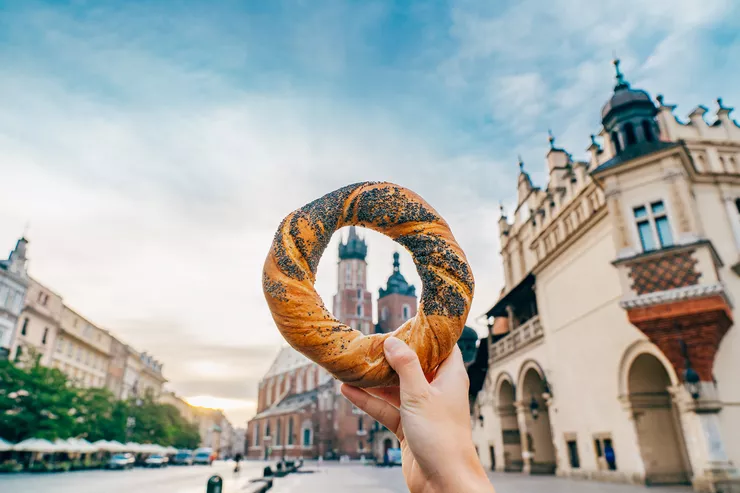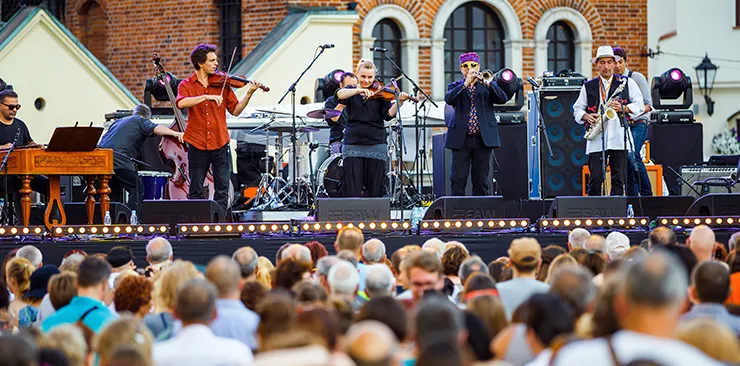





Prized and palatable peasant fare.
If you’ve been fed up with all the sophisticated ideas and dishes of the gourmets, why not take a closer look at the food of the simple folk of the past that has not only survived to this day but is greatly cherished? We promise to boast and brag to you elsewhere about the honourable title of European Capital of Gastronomic Culture that Kraków won in 2019 and extol the city’s 18 restaurants listed by Michelin.

Even if our contemporary menus are much closer to those of kings than those of peasants of yore, here we will only speak of simple fare. What emerges as the most obvious among their number is the Obwarzanek, a characteristic pleated bread ring cooked before being baked. Despite the continuing discussion about whether it is more a pretzel than a bagel, it is available from street vendors throughout the region, especially in Kraków. Obwarzanki sprinkled with salt, poppy seed or sesame are just snacks for the road. The local bread capable of feeding the whole family is Chleb Prądnicki with loaves that traditionally weighed two stone (yes, that is 28lb!) and a recipe dating back to the 14th century.
A local delicacy enjoyed first by royalty and their courts and later by the Jewish population is carp from the Carp Valley around Zator. Another fish that is a local specialty is the Ojców Trout. As in the times before fridges these would quickly go off, they were salted with salt mined in Wieliczka and Bochnia. So in addition to the mines, their salt is still available and makes a great souvenir.
Quite obviously, local delicacies include all the produce of traditional farms. This ranges from cheeses via plentiful cold cuts and sausages (which however, were only eaten on the most special occasions) to different types of honey.
Małopolska, like all of Poland, is famous for the practice of fermenting vegetables and, less often, fruit. Yes fermenting, as this is precisely what happens to them when they are pickled for a time in brine. This healthy practice known in many places around the globe for millennia is now becoming popular and fashionable as part of a healthy lifestyle. Poland’s most famous place for sauerkraut is Charsznica in northern Małopolska. The village even opened a cabbage museum! The other most popular pickled vegetable is the cucumber turned into a gherkin. Beetroot and rye have been pickled for centuries to make soups. The Kraków red borscht uses zakwas, a fermentation starter that gives it a rich aroma and deep red colour, while the Małopolska Żurek (sour rye soup) made of fermented rye comes with pieces of sausage, halves of eggs, and sometimes horseradish. In restaurants it is often served in small breads.
All simple and tested over time. Now it’s simply time for you to come and test them.
Cherishing the simple dishes of olden days, both those described above and many others, we have had many of them registered and certified for quality by the EU to protect the recipes and ensure the highest quality for the consumer.
There is no vinegar in anything kiszone. The delicious ogórki kiszone gherkins come from barrels filled with brine, with garlic, dill and other herbs and sometimes nuts added to taste. They have never had any contact with vinegar (unlike the industrial ogórki konserwowe). Kapusta kiszona sauerkraut goes through the same process, though the “flavourings” differ, and often include carrots and apples.
In the Middle Ages, carp from what is today Carp Valley around Zator was a dainty dish to set before the king. The royal purveyors sent it frozen by the sleighload to Wawel Castle, where, defrosted and prepared, it was served to Their Royal Highnesses.








